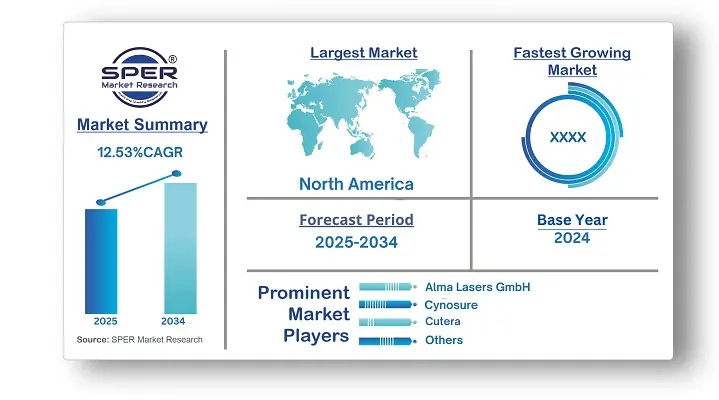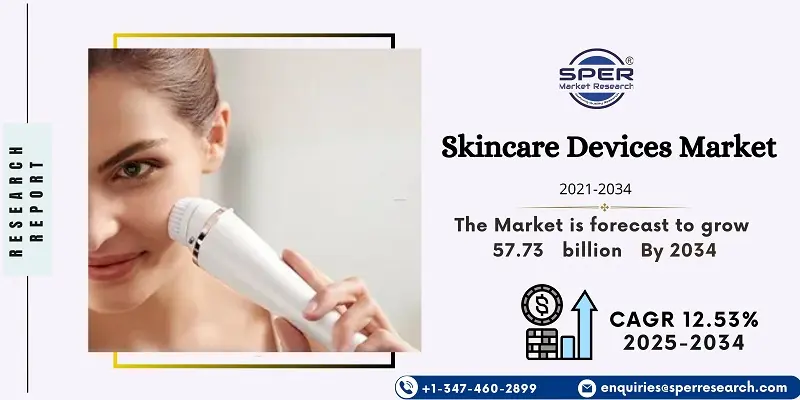Skincare Devices Market Introduction and Overview
According to SPER Market Research, the Global Skincare Devices Market is estimated to reach USD 57.73 billion by 2034 with a CAGR of 12.53%.
The report includes an in-depth analysis of the Global Skincare Devices Market, including market size and trends, product mix, Applications, and supplier analysis. The global skincare devices market is expected to reach USD 17.73 billion in 2024, with a compound annual growth rate (CAGR) of 12.53% between 2025 and 2034. The rising frequency of skin cancer and other skin problems contributes significantly to the growing demand for skincare equipment. Furthermore, factors such as people's increased knowledge and interest in aesthetic appeal, combined with technological developments in skincare devices and an increase in disposable wealth, are driving significant adoption of these devices.
By Product Insights
The market is divided into two segments based on product type: diagnostic devices and therapy devices. The treatment devices category generated the highest revenue in 2024 and is anticipated to expand at the fastest rate over the course of the forecast period. This is primarily because of the broad range of applications in dermatological treatment and the advancements in laser device technology. Among treatment devices, the laser devices segment also had the largest revenue share in 2024 and is predicted to have the highest growth. Lasers are used to treat skin issues like acne and wrinkles, and efforts are made globally to increase awareness of skin problems.
By Application Insights
The market is divided into treatments such as hair removal, skin rejuvenation, wrinkle removal, and skin resurfacing, acne, psoriasis, and tattoo removal, body contouring and fat removal, cellulite reduction, and vascular and pigmented lesion removal. The hair removal application category dominated the skincare device market and accounted for the majority of revenue in 2024. Hair removal equipment, particularly laser devices, have been shown to be safer for all skin tones and hair colours, as well as to permit less unpleasant treatment processes, hence driving market expansion.
By End-User Insights
The market is divided into hospitals, clinics, and other categories based on end users. Because hospitals have access to cutting-edge skincare products, the hospital segment dominated the market and generated the highest revenue in 2024. Additionally, the variety of treatment options has boosted visits for skin disease diagnosis and treatment in these facilities.
The clinic segment is expected to grow the fastest from 2025 to 2034, driven by the increasing number of clinics offering dermatology services and lower treatment costs compared to hospitals, attracting more patients.
Regional Insights
North America led the skincare devices market, holding the largest revenue share in 2024. Key factors for growth in this region include the rising rates of skin cancer and skin diseases like acne, rosacea, and eczema, along with greater use of cosmetic procedures.
Asia Pacific is projected to grow the fastest from 2025 to 2034, driven by increased medical tourism. Advancements in medical technologies and affordable treatment options, along with a growing awareness of beauty among men and women, are expected to boost the market.
Market Competitive Landscape
The report includes a competitive analysis and profiles of the leading companies in the skincare devices market, including Cutera, Lumenis Ltd., Cynosure Inc., Lutronic, Bausch Health Companies, Inc., Fotona, Sciton, Sisram Medical Ltd., Michelson Diagnostics Ltd., and Candela Corporation. The market for skincare devices has seen major players use product introduction, approval, and agreement as crucial developmental tactics to expand their product portfolios and establish a firm presence.
Recent Developments:
AviClear, a product of Cutera Inc., a world pioneer in medical aesthetics, was approved by the FDA in the United States in June 2023 to treat inflammatory acne vulgaris.
Scope of the report:
| Report Metric | Details |
| Market size available for years | 2021-2034 |
| Base year considered | 2024 |
| Forecast period | 2025-2034 |
| Segments covered | By Product, By Application, By End-User |
| Regions covered | North America, Latin America, Asia-Pacific, Europe, and Middle East & Africa |
| Companies Covered | Alma Lasers GmbH, Cynosure, Inc, Solta Medical, Inc, Cutera, Inc, Syneron Medical Ltd, Canfield Scientific, Inc, 3Gen, Aesthetic Group, Ambicare Health, Image Derm, Inc.
|
Key Topics Covered in the Report
- Global Skincare Devices Market Size (FY’2021-FY’2034)
- Overview of Global Skincare Devices Market
- Segmentation of Global Skincare Devices Market By Product (Diagnostic Devices, Treatment Devices)
- Segmentation of Global Skincare Devices Market By Application (Hair Removal, Skin Rejuvenation, Acne, Psoriasis, and Tattoo Removal, Wrinkle Removal and Skin Resurfacing, Body Contouring and Fat Removal, Cellulite Reduction, Vascular and Pigmented Lesion Removal, Others)
- Segmentation of Global Skincare Devices Market By End-User (Hospitals, Clinics, Others)
- Statistical Snap of Global Skincare Devices Market
- Expansion Analysis of Global Skincare Devices Market
- Problems and Obstacles in Global Skincare Devices Market
- Competitive Landscape in the Global Skincare Devices Market
- Details on Current Investment in Global Skincare Devices Market
- Competitive Analysis of Global Skincare Devices Market
- Prominent Players in the Global Skincare Devices Market
- SWOT Analysis of Global Skincare Devices Market
- Global Skincare Devices Market Future Outlook and Projections (FY’2025-FY’2034)
- Recommendations from Analyst
1. Introduction
1.1. Scope of the report
1.2. Market segment analysis
2. Research Methodology
2.1. Research data source
2.1.1. Secondary Data
2.1.2. Primary Data
2.1.3. SPER’s internal database
2.1.4. Premium insight from KOL’s
2.2. Market size estimation
2.2.1. Top-down and Bottom-up approach
2.3. Data triangulation
3. Executive Summary
4. Market Dynamics
4.1. Driver, Restraint, Opportunity and Challenges analysis
4.1.1. Drivers
4.1.2. Restraints
4.1.3. Opportunities
4.1.4. Challenges
5. Market variable and outlook
5.1. SWOT Analysis
5.1.1. Strengths
5.1.2. Weaknesses
5.1.3. Opportunities
5.1.4. Threats
5.2. PESTEL Analysis
5.2.1. Political Landscape
5.2.2. Economic Landscape
5.2.3. Social Landscape
5.2.4. Technological Landscape
5.2.5. Environmental Landscape
5.2.6. Legal Landscape
5.3. PORTER’s Five Forces
5.3.1. Bargaining power of suppliers
5.3.2. Bargaining power of buyers
5.3.3. Threat of Substitute
5.3.4. Threat of new entrant
5.3.5. Competitive rivalry
5.4. Heat Map Analysis
6. Competitive Landscape
6.1. Global Skincare Devices Market Manufacturing Base Distribution, Sales Area, Product Type
6.2. Mergers & Acquisitions, Partnerships, Product Launch, and Collaboration in Global Skincare Devices Market
7. Global Skincare Devices Market, By Product (USD Million) 2021-2034
7.1. Diagnostic Devices
7.1.1. Dermatoscopes
7.1.2. Microscopes
7.1.3. Biopsy Devices
7.1.4. Other Imaging Devices
7.2. Treatment Devices
7.2.1. Light Therapy Devices
7.2.2. Lasers
7.2.3. Electrosurgical Equipment
7.2.4. Liposuction Devices
7.2.5. Microdermabrasion Devices
7.2.6. Cryotherapy Devices
8. Global Skincare Devices Market, By Application (USD Million) 2021-2034
8.1. Diagnostic Devices
8.1.1. Skin Cancer Diagnosis
8.1.2. Other
8.2. Treatment Devices
8.2.1. Hair Removal
8.2.2. Skin Rejuvenation
8.2.3. Acne, Psoriasis, and Tattoo Removal
8.2.4. Wrinkle Removal and Skin Resurfacing
8.2.5. Body Contouring and Fat Removal
8.2.6. Cellulite Reduction
8.2.7. Vascular and Pigmented Lesion Removal
8.2.8. Others
9. Global Skincare Devices Market, By End-User (USD Million) 2021-2034
9.1. Hospitals
9.2. Clinics
9.3. Others
10. Global Skincare Devices Market, (USD Million) 2021-2034
10.1. Global Skincare Devices Market Size and Market Share
11. Global Skincare Devices Market, By Region, (USD Million) 2021-2034
11.1. Asia-Pacific
11.1.1. Australia
11.1.2. China
11.1.3. India
11.1.4. Japan
11.1.5. South Korea
11.1.6. Rest of Asia-Pacific
11.2. Europe
11.2.1. France
11.2.2. Germany
11.2.3. Italy
11.2.4. Spain
11.2.5. United Kingdom
11.2.6. Rest of Europe
11.3. Middle East and Africa
11.3.1. Kingdom of Saudi Arabia
11.3.2. United Arab Emirates
11.3.3. Qatar
11.3.4. South Africa
11.3.5. Egypt
11.3.6. Morocco
11.3.7. Nigeria
11.3.8. Rest of Middle-East and Africa
11.4. North America
11.4.1. Canada
11.4.2. Mexico
11.4.3. United States
11.5. Latin America
11.5.1. Argentina
11.5.2. Brazil
11.5.3. Rest of Latin America
12. Company Profile
12.1. Alma Lasers GmbH
12.1.1. Company details
12.1.2. Financial outlook
12.1.3. Product summary
12.1.4. Recent developments
12.2. Cynosure, Inc
12.2.1. Company details
12.2.2. Financial outlook
12.2.3. Product summary
12.2.4. Recent developments
12.3. Solta Medical, Inc
12.3.1. Company details
12.3.2. Financial outlook
12.3.3. Product summary
12.3.4. Recent developments
12.4. Cutera, Inc
12.4.1. Company details
12.4.2. Financial outlook
12.4.3. Product summary
12.4.4. Recent developments
12.5. Syneron Medical Ltd
12.5.1. Company details
12.5.2. Financial outlook
12.5.3. Product summary
12.5.4. Recent developments
12.6. Canfield Scientific, Inc
12.6.1. Company details
12.6.2. Financial outlook
12.6.3. Product summary
12.6.4. Recent developments
12.7. 3Gen
12.7.1. Company details
12.7.2. Financial outlook
12.7.3. Product summary
12.7.4. Recent developments
12.8. Aesthetic Group
12.8.1. Company details
12.8.2. Financial outlook
12.8.3. Product summary
12.8.4. Recent developments
12.9. Ambicare Health
12.9.1. Company details
12.9.2. Financial outlook
12.9.3. Product summary
12.9.4. Recent developments
12.10. Image Derm, Inc
12.10.1. Company details
12.10.2. Financial outlook
12.10.3. Product summary
12.10.4. Recent developments
12.11. Fotona
12.11.1. Company details
12.11.2. Financial outlook
12.11.3. Product summary
12.11.4. Recent developments
12.12. Others
13. Conclusion
14. List of Abbreviations
15. Reference Links


































